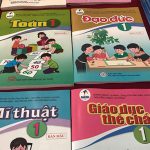Bộ đề thi giữa học kì 2 môn Tiếng Anh lớp 12 năm học 2018 – 2019, Bộ đề thi giữa học kì 2 lớp 12 môn Tiếng Anh năm học 2018 – 2019 là đề thi tra giữa kì 2 nhằm đánh
Xin giới thiệu đến các bạn Bộ đề thi giữa học kì 2 môn Tiếng Anh lớp 12 năm học 2018 – 2019 được chúng tôi tổng hợp chi tiết và đăng tải ngay sau đây.
Bộ đề thi giữa học kì 2 lớp 12 môn Tiếng Anh năm học 2018 – 2019 là đề thi tra giữa kì 2 nhằm đánh giá chất lượng học tập môn tiếng Anh của học sinh khối 12, đồng thời giúp các em ôn luyện chuẩn bị cho kỳ thi tốt nghiệp THPT Quốc gia sắp tới. Đề thi có đáp án chi tiết kèm theo. Mời các bạn cùng tham khảo.
Đề kiểm tra giữa học kì 2 môn tiếng Anh – Đề 1
I. Choose the option which has OPPOSITE meaning to the underlined word(s) .
Câu 1. We’d better speed up if we want to get to the concert in time
A. put down
B.lie down
C. slow down
D. turn down
Câu 2. Population growth rates vary among regions and even among countries within the same region.
A. fluctuate
B. restrain
C. stay unchanged
D. remain unstable
II. Read the passage and choose the correct answer to each of the following questions.
Many people believe that watching television has resulted in lower reading standards in schools. However, the link between television and printed books is not as simple as that. In many cases, television actually encourages people to read for example, when a book is turned into a TV series, its sales often go up.
One study of this link examined six-year-old children who were viewing a special series of 15-minute programmes at school. The series was designed to encourage the love of books, as well as to develop the basic mechanical skills of reading. Each programme is an animated film of a children’s book. The story is read aloud while certain key phrases from the book appear on the screen, beneath the picture. Whenever a word is read, it is also highlighted on the TV screen.
One finding was that watching these programmes was very important to the children. If anything prevented them from seeing a programme, they were very disappointed. What’s more, they wanted to read the books which the different parts of the series were based on.
The programmes also gave the children more confidence when looking these books. As a result of their familiarity with the stories, they would sit in pairs and read the stories aloud to each other. On each occasion, the children showed great sympathy when discussing a character in a book because they themselves had been moved when watching the character on TV.
Câu 3. What is the main idea of the book?
A. The simple link between television and books.
B. The ways of children reading books and watching TV.
C. The advantage of books over television.
D. The influence of television on reading books.
Câu 4. When does television encourage people to read ?
A. When children are watching an animated film on TV.
B. When a book is made into a TV series .
C. When there are no interesting programs on TV.
D. When a book appears on the screen.
Câu 5. How did children feel when viewing a special series of 15-minute program at school?
A. They felt bored.
B. They felt confident.
C. They felt disappointed.
D. They felt excited.
Câu 6. What kind of film is each program?
A. An educational film.
B. A story film of a children’s book.
C. An animated film of a children’s book.
D. A documentary film of children’s life.
Câu 7. What advantage did children have from this program?
A. They became more sympathetic.
B. They made more friends.
C. They read books with more interest and confidence.
D. They became more interested in watching TV.
III. Read the passage and choose correct word or phrase that best fits each of the numbered blanks.
BOOKS
Nearly all the discoveries that have been (8)_______ through the ages can be found in books. The invention of the book is one of humankind’s (9)_______ achievements, the importance of (10)_______ cannot be overestimated. Books are very adaptable, (11)_______ us with both entertainment and information. The production of books (12)_______ in Ancient Egypt, though not in a form that is recognised to us today. The books read by the Romans, however, have some similarities to the ones we read now. Until the middle of the 15th century, in Europe, all books were written by hand. They were often beautifully illustrated and always rare and expensive. With printing came the possibility of cheap, larze-scale publication and distribution of books, making knowledge more widespread and accessible.
Câu 8.
A. done
B. made
C. achieved
D. attained
Câu 9.
A. giant
B. greatest
C. huge
D. largest
Câu 10.
A. that
B. who’s
C. whose
D. which
Câu 11.
A. giving
B. meeting
C. offering
D. providing
Câu 12.
A. began
B. set
C. arose
D. carried out
………………..
Đề kiểm tra giữa học kì 2 môn tiếng Anh – Đề 2
I. Read the following passage and mark the letter A, B, C, or D on your answer sheet to indicate the correct answer to each of the questions
Long before they can actually speak, babies pay special attention to the speech they hear around them. Within the first month of their lives, babies’ responses to the sound of the human voice will be different from their responses to other sorts of auditory stimuli. They will stop crying when they hear a person talking, but not if they hear a bell or the sound of a rattle. At first, the sounds that an infant notices might be only those words that receive the heaviest emphasis and that often occur at the ends of utterances. By the time they are six or seven weeks old, babies can detect the difference between syllables pronounced with rising and falling inflections. Very soon, these differences in adult stress and intonation can influence babies’ emotional states and behavior. Long before they develop actual language comprehension, babies can sense when an adult is playful or angry, attempting to initiate or terminate new behavior, and so on, merely on the basis of cues such as the rate, volume, and melody of adult speech.
Adults make it as easy as they can for babies to pick up a language by exaggerating such cues. One researcher observed babies and their mothers in six diverse cultures and found that, in all six languages, the mothers used simplified syntax, short utterances and nonsense sounds, and transformed certain sounds into baby talk. Other investigators have noted that when mothers talk to babies who are only a few months old, they exaggerate the pitch, loudness, and intensity of their words. They also exaggerate their facial expressions, hold vowels longer, and emphasize certain words.
More significant for language development than their response to general intonation is observation that tiny babies can make relatively fine distinctions between speech sounds. In other words, babies enter the world with the ability to make precisely those perceptual discriminations that are necessary if they are to acquire aural language.
Babies obviously derive pleasure from sound input, too: even as young as nine months they will listen to songs or stories, although the words themselves are beyond their understanding. For babies, language is a sensory-motor delight rather than the route to prosaic meaning that it often is for adults.
Câu 1. What does the passage mainly discuss?
A. The differences between a baby’s and an adult’s ability to comprehend language
B. How babies perceive and respond to the human voice in their earliest stages of language development
C. How babies differentiate between the sound of the human voice and other sounds
D. The response of babies to sounds other than the human voice
Câu 2. Which of the following can be inferred about the findings described in paragraph 2?
A. The mothers observed by the researchers were consciously teaching their babies to speak
B. Babies ignore facial expressions in comprehending aural language
C. Babies who are exposed to more than one language can speak earlier than babies exposed to a single language
D. Mothers from different cultures speak to their babies in similar ways
Câu 3. According to the author, why do babies listen to songs and stories, even though they cannot understand them?
A. They understand the rhythm
B. They can remember them easily
C. They focus on the meaning of their parents’ word
D. They enjoy the sound
Câu 4. What point does the author make to illustrate that babies are born with the ability to acquire language?
A. Babies are more sensitive to sounds than are adults
B. Babies notice even minor differences between speech sounds
C. Babies begin to understand words in songs
D. Babies exaggerate their own sounds and expressions
Câu 5. Why does the author mention a bell and a rattle in paragraph 1?
A. To explain how babies distinguish between different nonhuman sounds
B. To give examples of typical toys that babies do not like
C. To give examples of sounds that will cause a baby to cry
D. To contrast the reactions of babies to human and nonhuman sounds
Câu 6. The passage mentions all of the followings as the ways adults modify their speech when talking to babies EXCEPT…..
A. speaking more loudly than normal
B. using meaningless sounds
C. giving all words equal emphasis
D. speaking with shorter sentences
Câu 7. The word “They” in paragraph 2 refers to ….
A. babies
B. mothers
C. investigators
D. words
………………
Mời các bạn tải file tài liệu để xem thêm nội dung chi tiết











